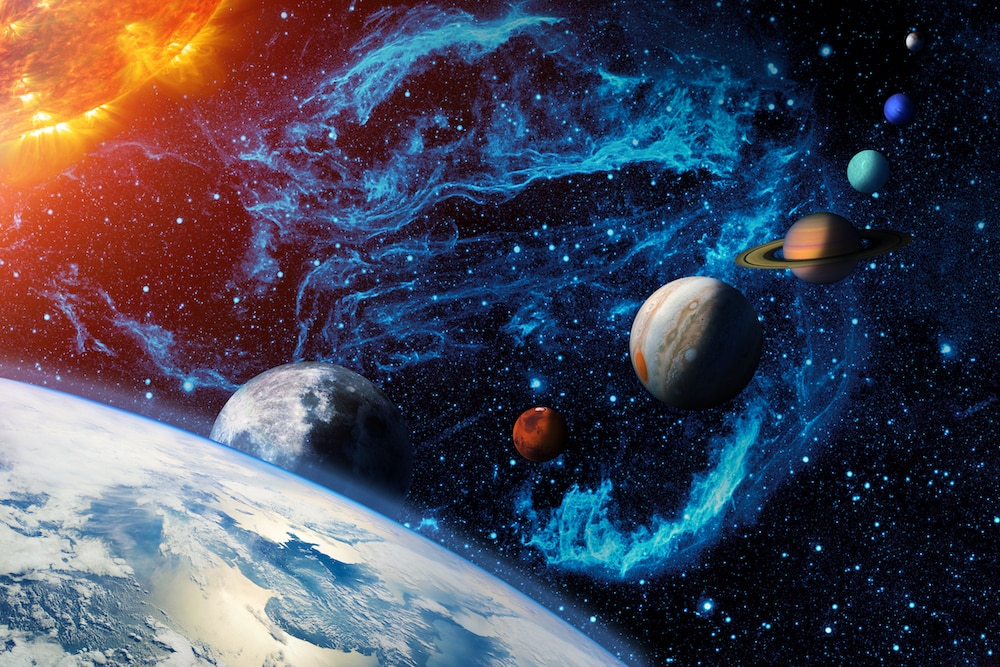Create a free profile to get unlimited access to exclusive videos, sweepstakes, and more!
The solar system is really messed up (and it might mean Planet 9 exists)
Blame it on gravity.

Billions of years ago, when it was first emerging from clouds of gas and dust, the solar system was supposedly in order. Then gravitational forces threw everything off.
What happened in the early solar system was not exactly like the thermonuclear explosion that blasted the Moon from its orbit in Space: 1999. Even though no nuclear waste was lying around like it was in the movie, phenomena that occurred back then still had enough power to to throw off some immense planets. The gas giants — Jupiter, Saturn, Neptune, Uranus, and possibly one more unknown body that could have been the elusive Planet 9 — were floating around the nascent Sun in circular and even orbits... until they were perturbed.
How did these enormous planets end up where they are now? As the dusty, gaseous protoplanetary disc slowly dissipated, the gas giants’ orbits supposedly went from being evenly spaced and circular to unevenly spaced and oblong. The Nice model (as in Nice, France) states this happened because of chaotic instability. Researcher Seth Jacobson of the University of Michigan, who coauthored a study recently published in Nature, and his team suspected something else and wanted to find out what was really behind the shift.
“The terrestrial planets would have finished forming by the time of the Nice instability, yet their orbits don't seem to record such a massive dynamical instability,” Jacobson told SYFY WIRE. “It provoked us to question whether a different giant instability triggered earlier in Solar System history could explain many of the same phenomena as the original Nice model.”
Something else that almost sounds like it came out of Space: 1999 had Jacboson rethinking that model. The Moon was thought to have endured rapid-fire impacts by asteroids and other objects in what has been called a terminal cataclysm. But he believes these strikes, which eventually formed huge basins, probably didn’t all happen at once. This was more likely a series of impacts that occurred over a long stretch of time as hunks of rock left over from planetary formation smacked the lunar surface. Maybe those planetesimals were jealous.
Instead of the type of instability and bombardment of the Moon that is suggested by the Nice model, it is possible that a “rebound” effect re-orbited the gas giants. Such planets tend to creep towards their star during its early phases of development. When the proto-star hits puberty, it has already accumulated most of the primordial gas surrounding it, and the gas in the disc becomes less dense. It also heats up and creates a photoevaporation front. This is where the disc is eaten from the inside out, with gas closest to the star being ionized (molecules gain or lose electrons) by its intense radiation.
“The gravitational interactions between each planet and the disc change because there is no longer as much gas interior to the planet as there was prior to photoevaporation,” said Jacobson. “This causes a change in the direction of the migration of the planet, what we call the rebound effect.”
So when the gas giants were too close to the photo evaporation front, that explains why they started to back off. The only exception is Jupiter because it already cleared out enough gas in the disc to get to the immense size it is now. However, when the others retreated from the Sun, they destabilized the solar system. Their orbital resonances that were caused by moving towards the Sun were disturbed. An orbital resonance is the gravitational influence of orbiting bodies in space on each other because their orbital periods are at a ratio of two integers (such as 3:5). After the gas giant resonances were broken, everything they passed reacted to them.
The chaos eventually calmed down, so the new orbits of the gas giants stabilized, but their eccentric orbits are evidence of that ancient disturbance. Jacobson and his team created simulations of these interactions in which gravitational forces are constantly changing the positions and velocities of the Sun and planets. But what does any of this have to do with Planet 9? Researcher David Nesvory of the Southwest Research Institute (SwRI) thinks that a change in Jupiter’s axis might have thrown out an extra ice giant in the solar system.
“If the Solar System were still in its natal stellar birth cluster, then it's possible that, rather than this hypothetical ice giant becoming a free-floating planet, it could have been deflected by nearby stars onto a distant orbit around our Sun, just like the purported Planet 9,” Jacobson said.
There is a chance that there really is a rejected ice giant lurking 50 billion miles from the Sun. So you get an idea of how far that is, it's 47 billion miles further from our star than Neptune. Maybe someday it will come out of hiding.

























